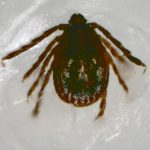
Asian Long-horned Tick (Adult Female). Credit: Jeremy Seto
Cases of a lethal tick-borne virus in Japan are reportedly set to start passing the 100-people-per-year mark for the first time since record keeping on the condition began in 2013.
The National Institute of Infectious Diseases announced on Nov. 19 that the 2019 total of 96 people affected with Huaiyangshan banyangvirus, also known as the SFTS virus, had surpassed the previous high of 90 in 2017. Additionally, the mortality rate is high, and due to the risk of infection being passed on by pets, the institute is warning people to be cautious.
The virus that causes SFTS was discovered by a group of Chinese researchers in 2011. It lies dormant in the body for around six days to two weeks, when it then shows symptoms including a fever, diarrhea and bloody bowel discharges. Mortality rates of 30% have been reported. Only symptomatic treatment is available for those suffering from the virus, and there is no vaccine.
The institute has been seeking reports from medical institutions across the country regarding all patients since 2013, and an upward trend has been visible since the first set of reports showed 40 patients in the initiative’s first year.
It is believed that there has not been an increase in infections, but rather that as a newly understood disease it has gradually become more easily recognized by medical professionals.
As of the end of October, an overall total of 491 patients had been diagnosed with the condition, and at the time those reports were filed 70 of them had died. It is possible that the number of the deceased has increased since that time. SFTS is particularly dangerous for elderly people, with 90% of recorded cases among those aged 60 and over.
The virus is carried by wild animals including deer and boars; if a tick (such as the Asian longhorned tick) sucks the blood of an infected animal and then later bites into another one, it passes on the virus. While it is important to be vigilant when out in hills and fields, there is also a danger of pets transmitting the disease to their owners at home after going outside.
Masayuki Saijo, head of the institute’s Department of Virology 1, said, “When your pet is feeling unwell, wear protective items including thick gloves, and try not to let them bite you.”
Source: The Mainichi

















